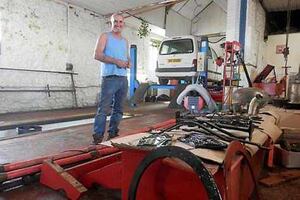Classic fire engine found
FOR decades it has languished neglected behind one of Fort Albert's arches.

FOR decades it has languished neglected behind one of Fort Albert's arches.
Now this 150-year-old fire engine is being lovingly restored to its former red and gold glory.
Constructed by Shand Mason of London in 1859, it was found in one piece around a month ago by staff of the States Works Department when they went to the fort to retrieve a piece of machinery.
They spotted the faded red woodwork of the appliance behind one of the fort's arches – exposed because the door that was shielding it had been blown off by the wind.
It is now lying in pieces at the States Works Department depot at the Butes, where Chris Dowden is carefully restoring it in any spare minute he gets. He is hoping it will be ready in time for Alderney Week, with its moving parts in working order.
Shand Mason fire engines are in museums all over the world. Alderney's example had first come to light during the removal of an old store in Ollivier Street in 1975. Then, it appears, it was moved to Fort Albert.
'As soon as I saw the plate, dating it to 1859, I knew we couldn't just leave it there like that, to rot,' said Mr Dowden. 'Two weeks ago, we got it back to the workshop and took it apart and cleaned all the parts.'
He looked the model up on the internet and found one in a museum in New Zealand. He used that for guidance on how they should be painted. He intends to have the brass shining like new, and gold embellishment along the sides mirroring the model in New Zealand.
The cart is made of oak and the rest is steel and brass. It is 12ft-long and 6ft-wide across the axles.
Mr Dowden can restore it only between States jobs, but he hopes that it can be wheeled out for Cavalcade Day on the Butes.
'It should go in the museum, but if they don't have space it could go in one of the empty shops,' he said. 'It's part of Alderney's history and deserves to be shown off.'
The old fire engine was last used on a fire which gutted the then newly-built Scots Hotel in the 1930s. The handles on either side of it are raised and lowered by six-to-10 men and these drive the pumps inside, which are immersed in oil and are still in working order. The only water supply was from wells.





